Hokkaido, Land of the Ainu | a conversation with Elizabeth Sanjuan
Elizabeth Sanjuan is a photographer from Hollywood, Florida. We recently had her exhibition, “Hokkaido Land of the Ainu,” up in the gallery. This body of work is a pictorial etude, showcasing the home of the native people of Japan, the Ainu, without them being physically present in the photographs. The elegantly stark winter images of bare trees and bare structures in snow allow us to imagine life in the landscape, without the intrusion of even a single footprint.
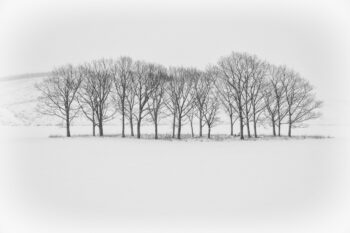
Kevin: Hi Elizabeth, first I want to thank you for approaching us about having an exhibition of your beautiful body of work in the gallery and for coming all the way from Florida to the reception!
From our brief conversations and small time together I perceive that you have a social and environmental consciousness and are wanting the viewer to connect with your imagery in both an aesthetic and a visceral way.
Can you tell us how you came to photography and how and if your Cuban background, growing up in Miami, informed your worldview and your photography practice?
Elizabeth: Thanks, Kevin and Amanda for the opportunity to speak about my work and for the opportunity to exhibit in your fabulous gallery.
I think many factors influenced my Hokkaido work. I grew up in a very modest home, but with a brilliant abuela (grandmother), who instilled in me a fervent love of reading. I traveled the world through books as a youth. I also had a few exceptional teachers who taught me about the importance of our natural environment, and why we must exhibit care and respect for Mother Earth. The “Keep America Beautiful” campaign of the 1960s and 1970s had an enormous influence on me. I vividly recall the tears rolling down the face of Iron Eyes Cody in his iconic “Crying Indian” commercials as I write this.
Fast forward to being a teen and my first travels to Europe. I was enthralled with the marvelous architecture and breathtaking museums. Shortly after, I had the opportunity to work for an airline, and this furthered my ability to discover the world. The more I travelled, the more I wanted to document the experience to show my family and friends what a diverse and incredible world existed outside of Florida. The camera, therefore, became my constant travel companion. I would bring back rolls and rolls of film!
Having the women in my life run a strict and orderly home also influenced me. In my Cuban household, flip flops, sneakers and shorts were never allowed. Every outing demanded its appropriate article of clothing, hairstyle, and accessory. Order, cleanliness, and respectability were priorities. This was especially the case when it came to the home. An unconscious force seems to propel me to have a broom or mop in my hands at all hours of the day, an eccentricity that my husband only understood when he saw every woman in Cuba doing the same. I see this same instinctive drive for cleanliness and order directing many of my images. I naturally recoil from chaos and search for the serene.
There is similar respect and reverence for quiet order in the Japanese way of life. For me it is especially palpable in the winter. As I mature, I find myself drawn even more toward peace and introspectiveness. I would say the work is a culmination of self-reflection, my spiritual journey and a desire to see a world in peaceful, quiet and graceful way.
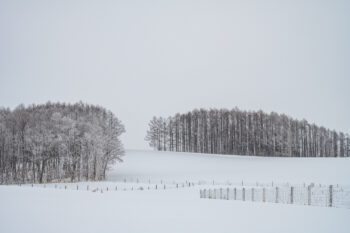
Kevin: Amanda can attest to the fact that I am certainly not a Cuban woman in my approach to housework.
Your gallery talk about the Hokkaido project was wonderful, folks are still talking about how moving and engaging it was. Can you tell us again about the images — your connection to the imagery, the single tree, etc.?
Elizabeth: I appreciate your comments about the gallery talk, as I am certainly not comfortable speaking in public. Fortunately, your hospitality helped me overcome my jitters.
The interesting thing about traveling to Hokkaido in the dead of winter, when the average temperature is 4 below zero, is that the conditions really encourage you to be laser-focused on what you want to convey. By now, you know that I love trees–not one specific kind or size—but all of them! I think trees are undervalued by our society. Most people really don’t realize the significant role they play in keeping us alive and the critical role they play in sustaining Mother Earth. Spring, summer and fall in Hokkaido are a buzz of activity as the locals plant, cultivate and harvest their crops. The land and the trees are working hard to produce and procreate. The winter is time to rest, recover and replenish. I find that images of Hokkaido’s trees deep in snow and silhouetted against grey skies speak eloquently about this process of serene renewal. The images of trees in this exhibition were made throughout the island. I photographed widely and frequently, constantly searching for trees that spoke most convincingly about the magic of this frozen serenity–courageous against the cold, unafraid of solitude and ready to shoulder the responsibility of jumping to life again next spring.
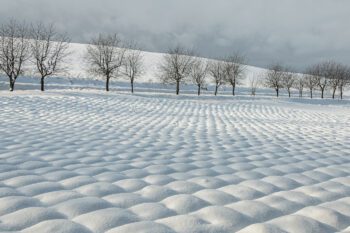
Kevin: Elizabeth could you tell us about the image of the skeletal greenhouse and the single tree and what thought process and or emotional connection you have with the images?
Elizabeth: Sure! With the image of the greenhouse framework I wanted the viewer to wonder: What is this thing and why did I photograph it? If we dig a bit deeper, the barren structure gives us time to ask ourselves: What do they plant? How do they cultivate and care for what they have planted? What is the result of their efforts? I think there is an analogy here that we can use to better understand the mental, emotional and physical aspects of our own lives. Given today’s fast-paced world where we live with a computer in our hands 24/7, we tend to lose connection with the inner self. We are so consumed with the “exterior” world that many of us have not done the work to feed and nourish our “interior” spirit. Having grown up in a difficult family dynamic, I learned from an early age that one needs to process and heal from the inside. It is a continuous journey of healing, self-love, and compassion that must go on for a lifetime. We must constantly “cultivate” what has been planted, remove the weeds, encourage the new growth, seek the sun and the healing rain. The framework within which this occurs can be bare and brutal, but with proper care, one’s life can bloom. The greenhouse frame is dark and forbidding in the snow, just as we all have had situations that have been challenging, and seemingly unalterable. Sometimes, we think it is easier to dismiss the situation and blame the framework, rather than to work though the challenge to come out ahead. You reap what you sow. Give yourself the gift to do the work–you are worth it.
After reading the book “The Hidden Life of Trees” by Peter Wohlleben, my love of trees deepened. If you have not read this book, I would highly recommend it, you will never look at a tree the same way again. As a young person, I thought I had to go at life alone, since I could not depend on anyone for my existence. I did not want to conform to societal norms or the pressure of a family engrained in what the “traditional” role of a woman should be in society. Usually, a tree needs other trees near them to thrive and survive, especially in harsh winter conditions that exist in Hokkaido. When I see a lone tree, I wonder: Was there a forest here at some point? Did humans purposely deplete the land of its natural existence, and leave one tree? I also ask myself how this tree has been able to survive and will it continue to grow and thrive given its current environment? The frigid temperatures, the accumulation of snow and the lack of protection from the wind are just a few things that may derail the tree’s ability to survive and flourish. I see my life mirrored in this tree. I reflect on the challenges of my youth and my growth as an adult and see a lot of similarities with this tree. I have realized that I am very capable of going at life alone, but it is much richer when it can be shared with others in this world.
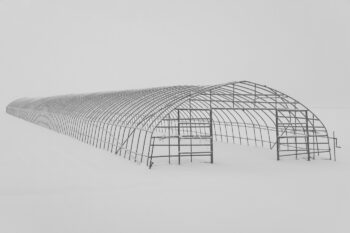
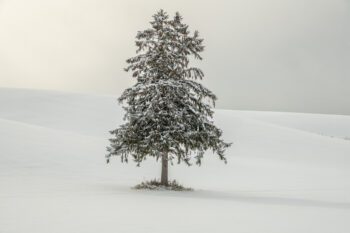
Kevin: Elizabeth, thank you for being so open and personal with your responses. The making of art can be cathartic, transcendent, healing and also an emotional battlefield. As someone that paints, I understand completely the emotional release and toll of living with a work of art for an extended period of time. I have been in awe of photographers, the initial phase of creation taking seconds, imbuing the work with so much emotion and insight. Thank you for taking the time to do this. And thanks again for allowing us to hang your wonderful work in the gallery.
Elizabeth: Thank you Kevin, you are absolutely correct in your comments, as I said previously, I have learned after many hardships that it is best (for me at least) to be open to the universe, to accept the what life is trying to teach and where it is guiding you. I think photography is an incredible tool that can give you the opportunity to explore the exterior world and the internal one. When you bring the camera to your eye, it is for a reason—something caught your eye and sent a signal to your brain and in a matter of seconds you made the decision to click. Last week I developed an intaglio print that brought tears to my eyes. Even a decade after I took the photograph, it still evoked a strong and visceral response in me. I hope that our conversation will help people look a bit deeper into the reasons that they photograph, what moves them and what fills their spirit. For me, I photograph for my pleasure and if I am lucky enough to have folks like Amanda and you appreciate my work, then it is icing on the cake! I thank you for this opportunity and the wonderful work you both do at A Smith Gallery.

To see more of Elizabeth’s work, follow this link.
